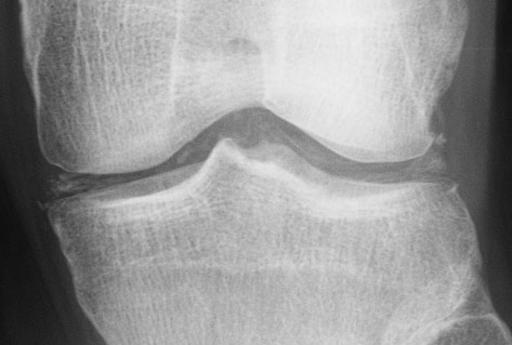A 78-year-old woman presented with hand weakness and difficulty walking. Past medical history included insulin-dependent diabetes mellitus, severe coronary artery and peripheral vascular disease, and hypertension. A computed tomographic scan of the cervical spine (Figure 1) and skull-base magnetic resonance imaging were performed, revealing a large, nonenhancing soft tissue mass (green arrow, Figure 1) at the C1-C2 articulation with areas of punctate and peripheral calcification (Figure 1, inset). There was no bony erosion, but the mass produced significant compression of the spinal cord and anterior medulla (purple arrow, Figure 1). The clinicoradiologic differential diagnosis included pannus of rheumatoid arthritis, chordoma, chondrosarcoma, metastasis, and pigmented villonodular synovitis.
Resection of the soft tissue mass yielded multiple fragments of tan-yellow fibrous tissue. The cut surface displayed multiple faint yellow specks. Microscopically, the tissue was predominantly fibrocartilage with hyalinization, myxoid change, neovascular proliferation, and dystrophic calcifications. Multifocal nodular deposits of basophilic material were present (Figure 2). Higher magnification examination of the deposits (Figure 3) revealed rhomboidal refractile crystals under polarized light (inset).
Calcium pyrophosphate dehydrate crystal deposition is an increasingly common form of arthritis in the elderly, affecting articular and periarticular soft tissues.1 Calcium pyrophosphate dehydrate crystal deposition can also occur in spinal structures, such as intervertebral disks, ligaments, bursae, articular cartilage, synovium, and joint capsules. Periodontoid calcium pyrophosphate dehydrate crystal deposition presenting as mass lesions of the craniocervical junction are rare causes of cervical pain accompanied by distal paresthesias and compressive myeloradiculopathy, placing affected patients at risk for odontoid fracture.2 These masses are typically isointense to hyperintense relative to neural tissue on T2-weighted magnetic resonance images, and isointense on T1-weighted images,3 although the present case was hypointense on T1-weighted images. The clinical differential diagnosis is broad and includes both inflammatory and malignant lesions.
References
1. Rosenthal AK. Pathogenesis of calcium pyrophosphate crystal deposition disease. Curr Rheumatol Rep. 2001;1:17-23.
2. Kakitsubata Y, Boutin RD, Theodorou DJ, et al. Calcium pyrophosphate dihydrate crystal deposition in and around the atlantoaxial joint: association with type 2 odontoid fractures in nine patients. Radiology. 2000;216:213-219.
3. Zunkeler B, Schelper R, Menezes AH. Periodontoid calcium pyrophosphate dehydrate deposition disease: "pseudogout" mass lesions of the craniocervical junction. J Neurosurg. 1996;85:803-809.
hn PhD
John A. Ozolek, MD; Charleen T. Chu, MD, PhD
Accepted for publication February 24, 2003.
From the Department of Pathology, Division of Neuropathology, University of Pittsburgh Medical Center, Pittsburgh, Pa.
Reprints: Charleen T. Chu, MD, PhD, Department of Pathology, Room A-516 PUH, 200 Lothrop St, Pittsburgh, PA 15213 (e-mail: chu@np. awing.upmc.edu).
Copyright College of American Pathologists Jul 2003
Provided by ProQuest Information and Learning Company. All rights Reserved



